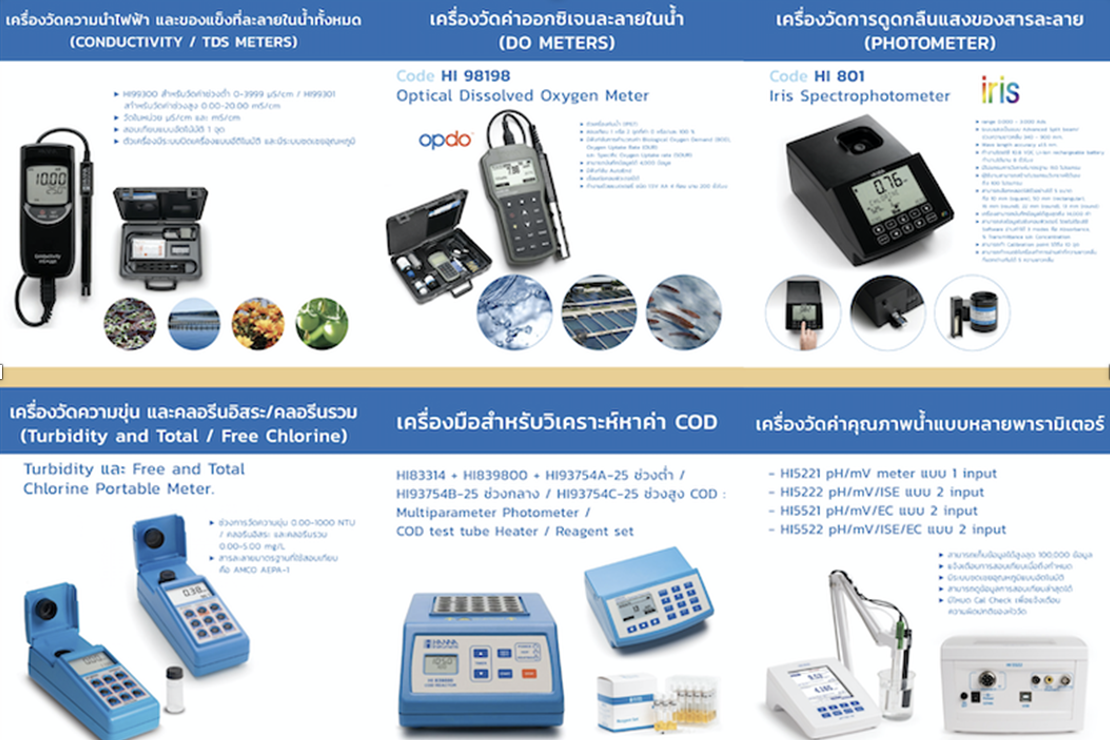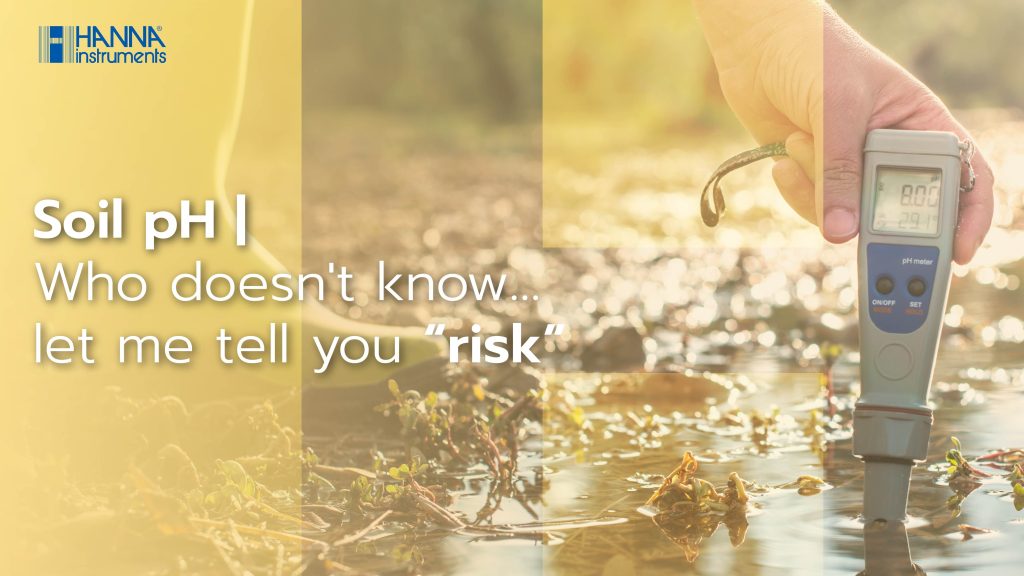No products in the cart.
Measuring Concentration Chemicals
Soil pH | Who doesn’t know…let me tell you “risk”
Soil pH improves plant absorption of nutrients from the soil. If the plant grows in soil with too little acidity, the leaves will turn yellow because the plant’s iron cannot be fully absorbed. As a result, the soil suitable for plant growth As a result, there must be a sufficient amount of acidity for the acidity to convert nutrients for easy absorption by plants. As a result, measuring the pH or pH in the soil is an issue that farmers must prioritize. Because of the high pH, humidity, temperature, and air are all important factors in crop yield, including profit and loss. As a result, a “pH meter” should be present (pH meter).
Soil conditions are best for growing plants.
Plants grow best in soil with a pH of around 6.5. because it is completely neutral However, some plants, such as blueberries, azaleas, and gardenias, thrive in acidic soil. As a result, soil with a pH of 4.5 – 5.5 is required. In order for plants to grow better, you should also study the soil pH before planting them.
Why is it important to check the pH level all the time?
Because there are numerous factors to consider, including minerals in the soil. and the amount of rain that falls each year Including the fertilizers we use to feed plants. All of these factors cause the pH of the soil to change over time. As a result, the pH of the soil must be constantly monitored and observed. To adjust the pH level of the soil so that it is suitable for plants.
- What does soil pH stand for?
pH is an abbreviation for Potential of hydrogen ion. It is a unit used to express the pH of a soil chemical produced by the hydrogen reaction. which splits into H+ (hydrogen ions) and OH- (hydroxide ions). The soil is acidic if the amount of hydrogen ions (H+) is greater than the amount of hydroxide ions (OH-). If the amount of hydroxide ions (OH-) is greater than the amount of hydrogen ions (H+), the soil is alkaline. however, if found in equal quantities It represents the soil’s neutral state.
to make it simple to comprehend The pH value will be displayed as a number between 1 and 14, with pH 7 representing neutral. If the pH of the soil is less than 7, it is acidic (acid soil), but only if measured. Any value greater than 7 indicates that the soil is alkaline (saline soil). Most soils require a pH in the range of pH 5-8, so a soil pH meter in the pH range of 3-8 should be chosen.
Don’t memorize the pH wrong,
if you’re wrong, that’s it. “seriously wrong”
Soil pH Severity Levels are usually classified according to pH according to the table below.
|
pH |
pH condition | pH |
pH condition |
|
< 3.5 |
strongest acid | 6.6-7.3 | neutral |
|
3.5-4.5 |
very strong acid | 7.4-7.8 |
slightly alkaline |
| 4.6-5.0 | very acidic | 7.9-8.4 |
moderately alkaline |
|
5.1-5.5 |
acidic | 8.5-9.0 | alkaline |
|
5.6-6.0 |
medium acid | > 9.0 |
very alkaline |
| 6.1-6.5 | slightly acidic |
|
A pH of 6.0-6.5, or “weakly acid,” is ideal for a soil pH suitable for plants in general. Plants have the greatest ability to utilize nutrients. Soils with a pH less than 5.5 (acidic) or greater than 8.5 (alkaline) are considered problematic for agriculture. because it is a low fertility, nutrient-deficient soil that is difficult to cultivate However, it should be considered in conjunction with the type of plants that you want to plant. Some species thrive in acidic soils. It is also possible to be extremely alkaline. For example, tea, durian, and pineapple are highly acidic; jackfruit, grapefruit, and tamarind are highly alkaline.
- The effect of acidic soil or alkaline against plants
In agriculture, it is recommended to control soil pH in the range of 6.0-6.5 only. Many people think that the effect will directly affect plant growth. But in reality, pH is a variable that controls the release of nutrients by plants in the soil. If released more than required, it is harmful to plants. Too little discharge is not good. should be released to fit.
The pH of each plant Based on information from the National Science and Technology Development Agency (NSTDA) as follows :
|
kind of plant |
pH |
|
Coconut, Banana, Sugarcane, Sunflower, Soybean |
6.0 – 7.0 |
|
corn, grass, ornamental plants |
5.5 – 7.0 |
|
lentils |
5.5 – 6.8 |
| Sorghum, Orange, Chili, Pumpkin, Peanut |
5.5 – 6.5 |
|
pineapple |
5.0 – 6.5 |
|
rubber |
4.0 – 6.5 |
| cantaloupe, okra, onion |
6.0 -6.5 |
|
yam |
5.6 – 6.0 |
|
tobacco |
5.4 – 6.0 |
|
Potatoes, cotton, coffee |
5.0 – 6.0 |
| watermelon |
5.0 – 5.5 |
| tea |
4.0 – 5.5 |
- How to adjust soil pH
It is critical to adjust the pH of the soil. Because it predicts soil fertility, it also allows farmers to assess soil conditions in advance in order to find ways to correct soil conditions before problems arise later.
Guidelines for solving acidic soil problems
- Use organic material to cover the soil.
- Adding compost
- Selection of plant species that are resistant to acidity.
- To improve the nutrient conditions of plants in the soil to be sufficient.
- Use of pH leveling mortar such as marl, dolomite lime.
*** It is not recommended to use biological fermentation because the fermented water has a high acidity.
A solution to the problem of alkaline soil
- Using mortar to adjust the pH level such as gypsum plaster.
- Use organic material to cover the soil.
- Use fermented water with a high acidity. watering regularly
- Selection of plant species that are resistant to alkalinity.
- Improving the nutrient conditions of plants in the soil to be sufficient.
The pH Meter is a highly precise and accurate instrument.
pH meters come in a variety of styles, including pen, hand-held, tabletop, and wall-mounted models. The use of a pH meter to measure pH is best suited for industrial applications. If the appropriate measuring tool is chosen for the application
pH Meter from Hanna

Hanna Instruments (Thailand)
Leading measurement instrument maker
WITH GREAT PRODUCTS, COME GREAT RESULTS.
Email Addresses
info@hannathaicom
CONTACT US
Line : @hannathailand
FB : HannaThailand
